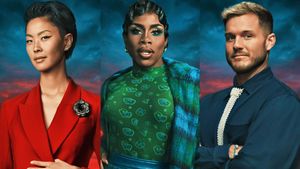Gay Pornography: Representations of Sexuality and Masculinity (I.B. Tauris), a new book by John Mercer of Britain's Birmingham City University, suggests the iconography in gay porn and the ideals that those images represent are far more nuanced and diverse than they might originally appear. Rather than being one-dimensional, Mercer's research shows that modern gay adult videos and imagery offer audiences a plurality of masculinities. A professor of gender and sexuality at the Birmingham Centre for Media and Cultural Research, Mercer is also coeditor of the Journal of Gender Studies, cofounder of Porn Studies, and an editorial board member for the journals Sexualities and Celebrity Studies.
Since moving online, gay porn has experienced an explosion in terms of the amount of content, diversity of material, and the access that viewers have to it. The sheer magnitude of the material available makes any comprehensive review difficult, but Mercer has spent nearly two decades researching how gay porn has impacted the development of masculinity in the gay community and beyond.
"People will talk about gay culture in isolation, but it is based on interaction with, [and] recycling and appropriation of, aspects of the wider culture," Mercer says, and it has undergone significant transformation over time, reflecting the social, cultural, and political environment of different eras. Evolving from the sexual revolution through the early days of the AIDS epidemic and into the modern era, gay porn is now accessed by millions of people around the globe, including citizens in some of the most sexually repressive nations in the world. And its iconography impacts even the development of heterosexual masculinities.
"The rhetoric and iconography of gay porn is informing the ways in which heterosexual men produce their bodies for erotic consumption," Mercer says. "Which is, in itself, contributing to the perpetual flux of masculinities men must contend with in modern times."
Case in point? Pubic hair. Many aspects of porn that have become essential elements -- such as camera angles or pulling out prior to ejaculation for the money shot -- originated in order to facilitate filming. These elements have also impacted what many consider to be masculine. Consider the near universal adoption of pubic hair removal in our post-porn era, even though such hair was once considered essential to masculinity.
Mercer's 240-page tome made its premiere in conjunction with an academic debate, "What It Means to be a Man in the 21st Century: Masculinity, Sex and Popular Culture," featuring Mercer and author Mark Simpson, the man who coined the terms "metrosexual" and "spornosexual." According to British Esquire, "the [latter] term, denoting men who strive to look like sportsmen or porn stars, marks the next stage in the evolution of the preening, mediated 'metrosexual'... and the rise in hypersexualized, homoprovocative imagery of sportsmen."
Mercer says gay porn today also reflects a "saturated" masculinity, so broadly defined and conceived that it can mean "many things, some of them contradictory in nature."
As a social construct, masculinity has changed over time, reflecting different interpretations of what's appropriate male behavior.
"Popular understandings of masculinity during most of the 20th century were largely about the idea that masculinity was a very narrowly defined gender identity," Mercer says. "Masculinity was hard to achieve and easily lost. In many ways, masculinity was understood as a tightrope walk, as it was all too easy to trip up and become 'feminine' or 'feminized.'"
Now we understand there are many different ways of being a man, beyond the cultural normative version of masculinity.
"A paradox that lies at the heart of gay porn is that it is, at points, both subversive and normative," Mercer argues. Makers of porn have adopted hetero norms about masculinity, while also developing subversive forms of masculinity, like twinks and bears.
"Masculinities are a multitude and are represented, likewise, in a multitude of ways," Mercer says. "And this is vividly evidenced in the types that populate the fantasy worlds of gay porn -- from the obvious 'twink' and 'jock,' but also 'chavs' and the hypermasculine gay male."
Mercer writes that this undermines "orthodoxies of masculine representation at the same time as producing new norms of gay sexual conduct and sexual performance."
He says gay porn today is a great tool to "understand how modern masculinity works. Looking at the way that male bodies are presented for erotic consumption is important, as this is now more widely part and parcel of the fabric of popular culture, and informs a vocabulary that men of all ages and identities [use to] construct themselves or think of themselves as sexually desirable online. [Gay porn] is no longer a marginal, taboo minority interest, but is in fact part of popular culture."




































































Charlie Kirk DID say stoning gay people was the 'perfect law' — and these other heinous quotes